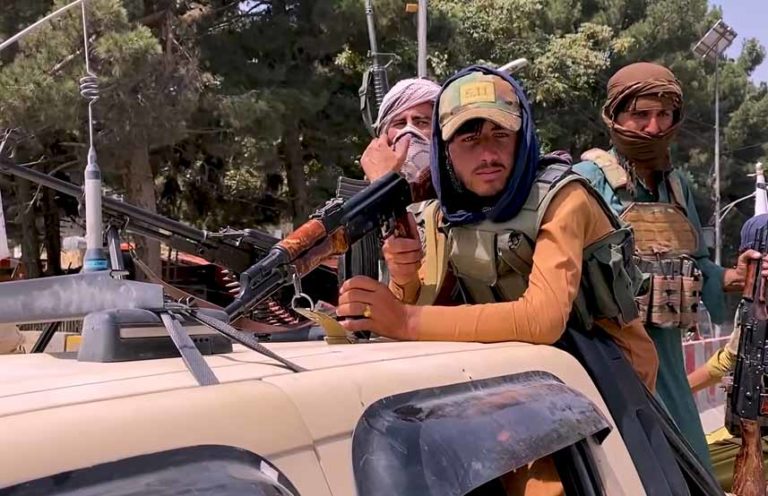
With the fall of the Afghan National Army, the Taliban has gained a trove of U.S. Military Weapons. Here's some of what's in their hands.
Difficult to miss, the ensuing chaos as the U.S. Military departs Afghanistan fills YouTube videos and nightly newscasts. Dramatic scenes of Afghan nationals attempting to escape the approach of Taliban fighters are dramatic and marks among the most turbulent chapters in American history. Less apparent, the trove of military weapons now in the hands of the insurgent forces presently in near-total control of the country.
Fleeing the Taliban onslaught, Afghan National Army (ANA) forces have abandoned or outright surrendered their arms to the insurgents. Almost to the gun, these weapons come from the U.S. Military. The situation is dire enough that Reuters reports the White House is considering launching an airstrike against some of the larger equipment. Even if this comes to pass, the Taliban comes out of the U.S. departure well-armed.
American Investment In Taliban Arms
According to a 2016 U.S. Government Accountability Office report, the Department of Defense had outfitted the ANA with some 884,311 pieces of military equipment since 2003. This includes nearly 600,000 weapons, 208 aircraft, and 76,000 vehicles of various types. In all, according to the Wall Street Journal, more than $80 billion over 20 years has been spent on the Afghan forces. Presumably, given the collapse of the country, most of this equipment is now in the Taliban's hands. But what exactly do they have?
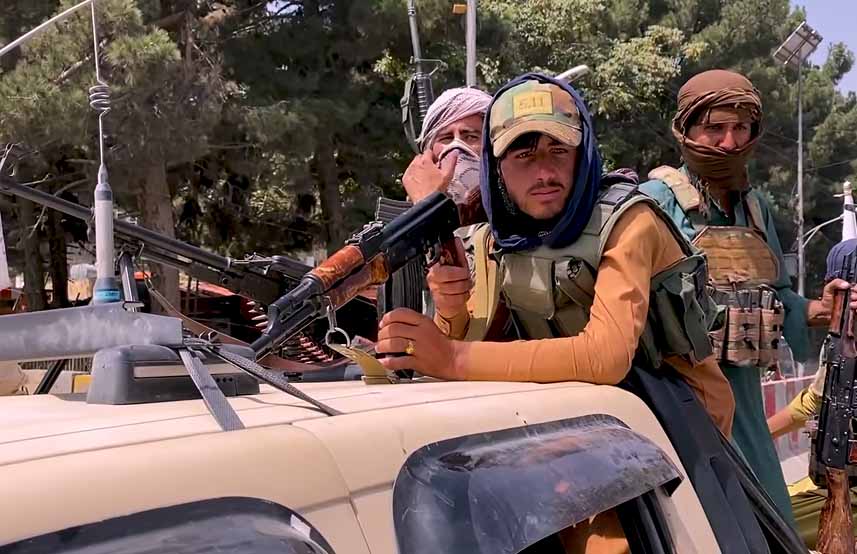
Gun Digest compiled a list of the likely small arms, vehicles, aircraft and equipment left behind in Afghanistan. By no means is our research definitive, given even the U.S. Military has had difficulty keeping tabs on exactly its supplies to the ANA. According to the Wall Street Journal, a December 2020 report found “[T]he Pentagon didn’t meet U.S. inspection requirements for weapons, inventorying only 40% of applicable military items from May 2019 to April 2020. However, there has been some records of what the U.S. has equipped the ANA with over the course of two decades and more than $80 billion of military spending. Here's what we found are the likely U.S. Military Arms now in the Taliban's possession.
U.S. Military Equipment Sent To Afghanistan
Beretta M9
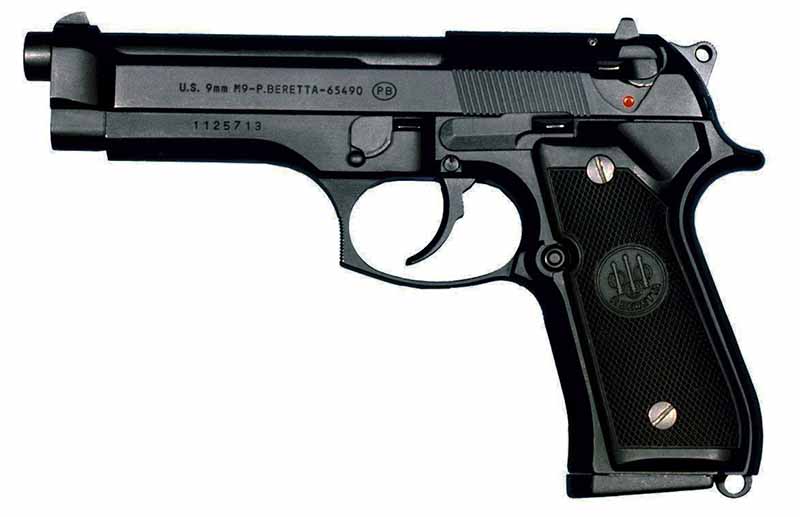
Recently replaced by the Sig Sauer P320 (designated the M17), the M9 was the standard-issue sidearm of the U.S. Military since 1985. The DA/SA 9mm replaced the iconic M1911A1 as the military’s go-to pistol, but never endeared itself to soldiers the same way as its predecessor. A 2006 report by the Center For Naval Analysis found of the soldiers who engaged the enemy with the pistol, only 58-percent were satisfied with the weapon—the lowest of any on the survey.
Sig Sauer M17/M18

Duty and compact variants of the P320 the U.S. Military recently adopted as its new sidearm. The striker-fired, double-stack 9mm pistols are manufactured by Sig Sauer and a known for their modular design, incorporating an internal chassis that is separate from the frame. This allows multiple configurations of the handgun, improved longevity. The pistols feed from both 17-round and 21-round magazines and have been praised for their accuracy and ergonomics compared to its predecessor the M9.
M16A2 Rifle

Likely the most abundant American weapon supplied to the ANA is the M16A2. This rifle was first adopted by U.S. Marines in the early 1980s, eventually seeing use by every branch until it began getting phased out in favor of M4 carbines in the late 1990s. Some are still in service with rear-echelon units like the Reserves and the National Guard. Like its predecessor, the M16A2 is chambered for 5.56 NATO but the barrel was appropriately rifled for the new SS109 or M855 62-grain projectile. Further changes included a more adjustable rear sight, the addition of a brass deflector and new furniture of a modified design using improved materials. The sheer volume of M16A2s sitting in American stockpiles by the early 2000s made them a prime candidate for equipping the new Afghan army.
M4 Carbine

The M4 is what effectively replaced the M16A2 in common U.S. military service. Derived from the CAR-15 which was originally developed for special forces in Vietnam, the M4 carbine is essentially a shortened and modified M16A4. The M4 features a 14.5-inch barrel with an external profile that allows the mounting of an M203 under-barrel grenade launcher. They also have a proportionally shorter gas system and handguard as well as a telescoping buttstock similar to the one designed for the CAR-15. The most substantial change on the M4 is the replacement of the carry handle rear iron sight with a Picatinny rail segment for mounting modern optics. The United States sold M4 carbines to the ANA on a few separate occasions for use with Afghani commandos and special forces, but these were not issued to standard ANA infantry like the M16A2.
M24 Sniper System
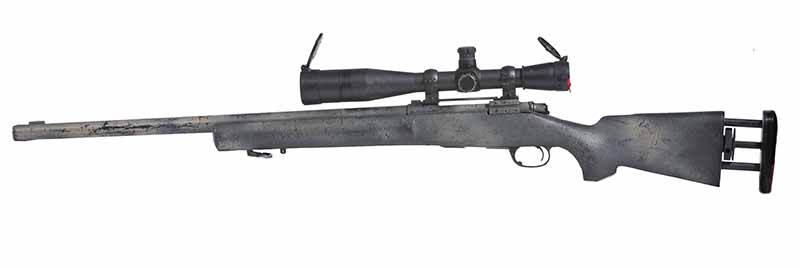
The primary sniper rifle of the U.S. Army for the past 30 years, the M24 is well regarded for its accuracy and performance in the field. Based on the push-feed, bolt-action Remington 700 the rifle was, by and large, chambered 7.62x51mm NATO (M24 and M24A2), however, in more recent times the rifle was modified to accept .338 Lapua Magnum, extending its range. Comparably, the 7.62 has an effective range of 875 yards, the .338 Lapua 1,640 yards. For the better part of its service, the 5-round rifle utilized the Leupold Ultra M3A 10×42mm fixed power scope or Leupold Mk 4 LR/T M3 10×40mm fixed power scope to get on target. H-S Precision provided many of the stocks, which at minimum were adjustable for length of pull, and some coming with a fixed cheekpiece.
M249 SAW (Squad Automatic Weapon)
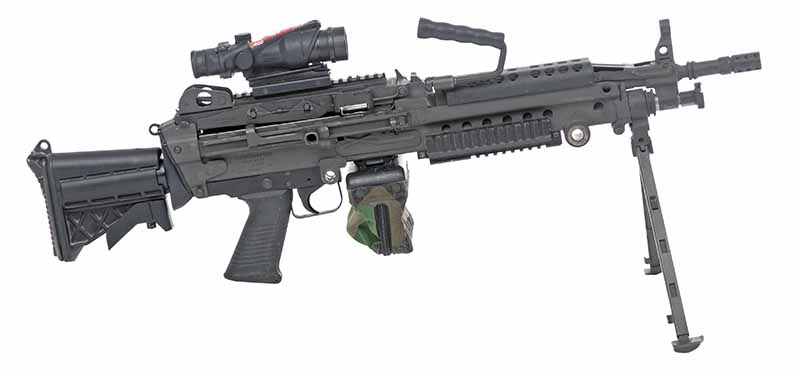
Designed to provide infantry squads with a high volume of fire, the M249 combines a high rate of fire with accuracy and portability. The light machine gun was adopted in 1984 and has been a mainstay in nearly every U.S. conflict involving ground combat since. Chambered 5.56x45mm NATO, the FN Herstel-manufactured machine gun is operated by a gas-actuated long-stroke piston and is air-cooled. Its feed mechanism is also versatile, capable of grazing off 30-round ATANG magazines or M27 disintegrating belts. At 18 pounds, the gun is easily transported to nearly any fight.
M240B Machine Gun

A general-purpose machine gun, the weapon is meant to bring heavier firepower to bear on the enemy than the smaller-caliber M249 SAW. Manufactured by FN Herstel, other variations of the 7.62x51mm NATO machine gun are often mounted on vehicles and aircraft, but the M240B is primarily an infantry weapon operate off an integral bipod or mounted on a tripod. A spare barrel is issued with each M240B, allowing barrel swaps to keep the air-cooled weapon in the fight. With a maximum rate of fire of 950 rpm, the machine generally feeds from a 100-round bandoleer containing a disintegrating metallic split-link belt.
M2 Browning Machine Gun

Among the longest-serving weapons in the U.S. Military’s arsenal, the .50-caliber heavy machine gun is also among the most versatile. The M2 or “Ma Deuce” has been mounted on vehicles, in aircraft, on ships and used off tripods. It’s overwhelming firepower on a target as both an anti-personnel and anti-material machine gun. In service since World War I, the John M. Browning-designed weapon doles out a lot of punishment, with an effective range of 2,000 yards and a cyclical rat up to 575 rpm. It is recoil-operated, air-cooled and belt-fed.
M134 Minigun

The six-barrel rotary machine gun has become among the most iconic U.S. Military weapons since it entered service in the early 1960s. The externally powered machine gun is best known for its extreme rate of fire, capable of delivering 2,000 to 6,000 rpm downrange. Generally, the M134 is mounted to vehicles and aircraft with its 41- to 85-pound weight making it prohibitive for infantry use. Chambered 7.62x51mm NATO, weapon feed from disintegrating M13 linked belt or linkless feeds. Dependent on its installation it utilizes 500- to 5,000-round belts.
M203 Grenade Launcher

The single-shot 40mm grenade launcher was adopted in 1969 and has been an infantry staple ever since. Originally, the under-the-barrel launcher was designed for use on the M16A1 but has been modified for use on the M4 carbine in modern conflicts. With an effective firing range of roughly 400 yards, its intended use is close fire support, mainly to reach enemies that cannot be hit by direct fire. The launcher fires several different rounds, from high-explosive to illumination and buckshot. Manufactured by several different companies, the M203 adds around 3-pound to a rifle.
Artillery
M114 Howitzer
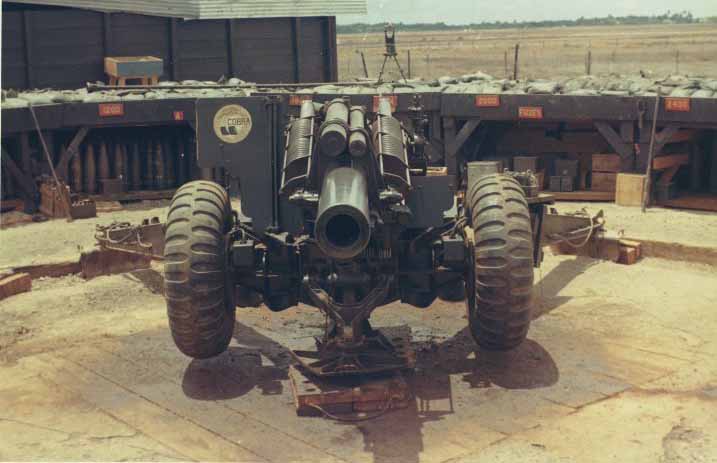
The medium artillery piece has seen service since World War II and is widely used by U.S. allies around the world. A versatile artillery piece, the 155mm howitzer is capable of shooting high explosive, smoke, chemical, nuclear and illumination rounds.
Vehicles
Up-armored HUMVEEs (M1151/M1152)
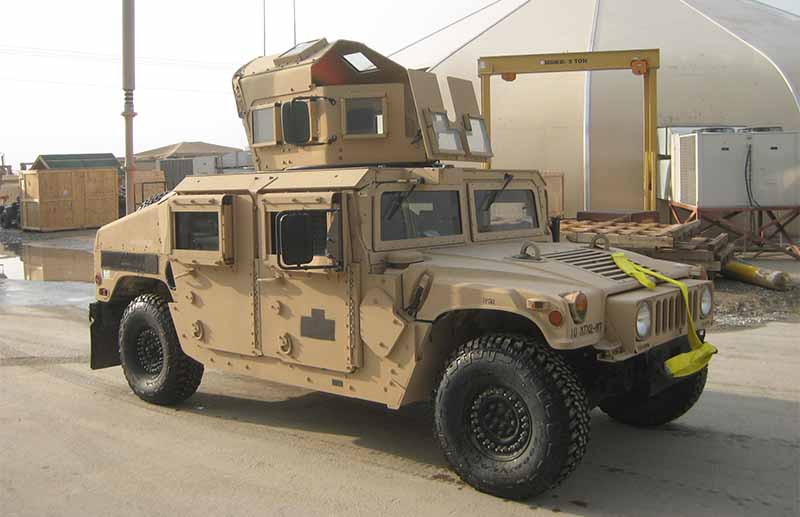
Essentially the traditional Humvee, armored to provide ballistic and mine protection. A variety of weaponry can be mounted on its turret.
M113 APC
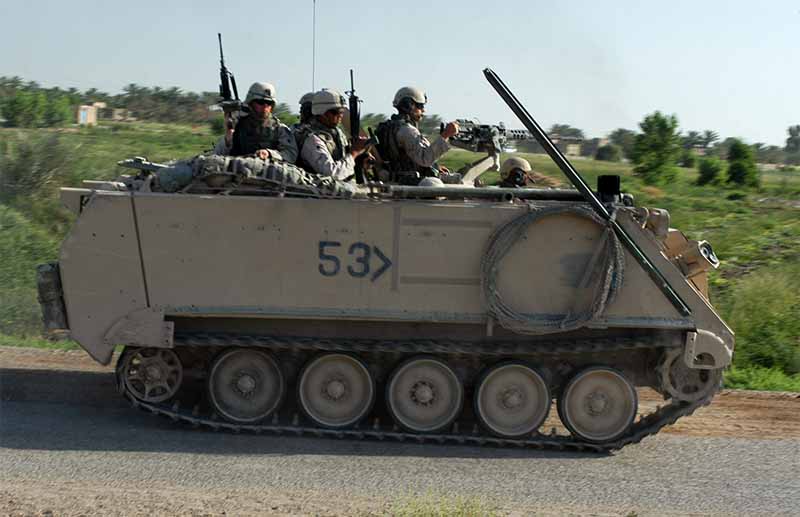
A fully-tracked armored personnel carrier, the M113 has 28mm to 44mm of 5083 aircraft-grade aluminum for armor. Provides all-around 7.62x51mm protection.
M577 Command Vehicle

A variant on APCs, the M577 was designed to function on the battlefield as a mobile command post, typically at the battalion level. In service since the Vietnam War.
M1117 ASV
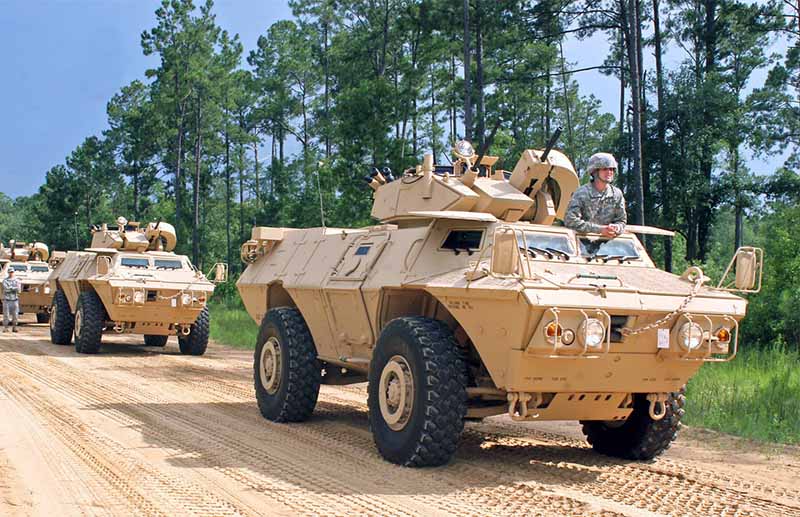
A wheeled, turreted and armored all-wheel vehicle is generally used to support police missions. The hull is mine-resistant and it features composite Modular Expandable Armor System (MEXAS) armor. Depending on its level, MEXAS can protect against small-arms fire, up to RPGs (Rocket Propelled Grenades). Typically armed with Mk19 Grenade Launcher, M2 Machine Gun or M240 Machine Gun.
Aircraft
U-60 Black Hawk
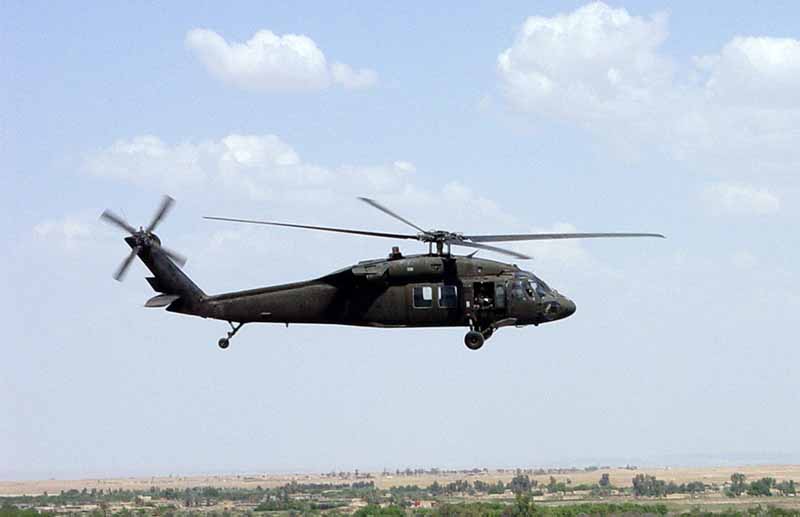
A front-line utility helicopter, the Black Hawk can ferry up 11 combat-loaded troops at a time and is capable of moving large pieces of artillery. Manufactured by Sikorsky Aircraft, the Black Hawk has four blades, a service ceiling of nearly 20,000 feet and a cruising speed of 152 to 159 knots.
A-29 Super Tucano
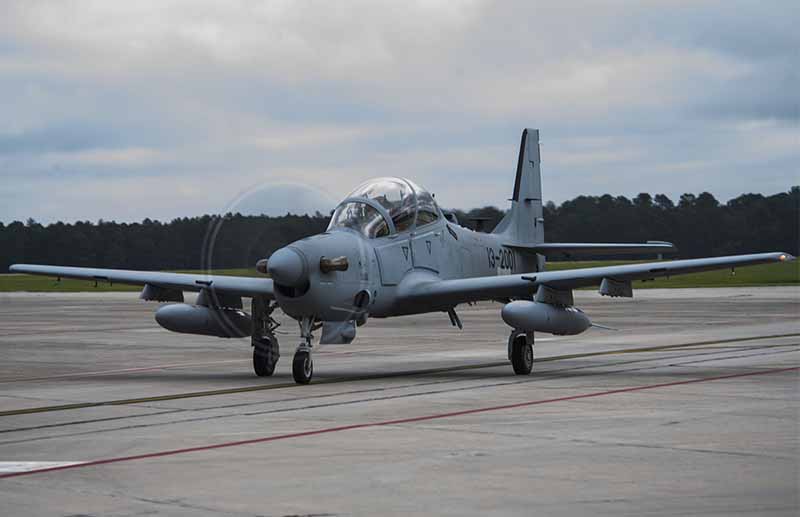
Brazilian-made (Embraer Defense and Security), the Super Tucano is a turboprop light attack aircraft. Capable of carrying a variety of weapons, from laser-guided munitions, the aircraft was used extensively in counter-insurgency operations in Afghanistan.
Other Equipment
- AN/PVS 7b Night Vision Goggles (Generation Unknown)
- 3 Million Rounds of Ammunition (Estimated)
- 100,000 2.75-inch Rockets (Likely Hydra 70)
- Anti-Tank Missiles (Likely FGM-148 Javelin and BGM-71 TOW)
- Ford Ranger Truck
- Ford F350
Widely Used Soviet Era Weapons
AK-47/AKM Rifles

Not every ANA troop was issued an American-supplied weapon, as especially in the earlier years of the conflict there weren’t enough to go around. Much of the ANA force’s equipment was Soviet in origin, some of it dating back to the ‘60s and ‘70s from when the USSR was assisting the Shah and then Daoud governments. Even more, weapons are likely leftover from the Soviet-Afghan War which saw Eastern Bloc weapons brought into the country by both the USSR themselves as well as the CIA during their support of the Mujahadeen. While Soviet forces primarily used AK-74s chambered for 5.45, these are no longer in common usage anywhere in Afghanistan. The prevalence of 7.62×39 ammunition, magazines and rifles ensured that AKMs and older AK-47s were what stayed in common usage. A random sample of Afghani AKs would likely feature examples not only manufactured in Russia but all other major AK-producing countries as well. A good amount of the famous reliability and longevity of the AK’s reputation stems from their prevalence in this region where they have been heavily used and poorly maintained for literal decades of fighting, with most still working just fine. Some contemporarily produced AKs were also supplied to the ANA by the United States as a supplement.
PK/PKM Machine Guns
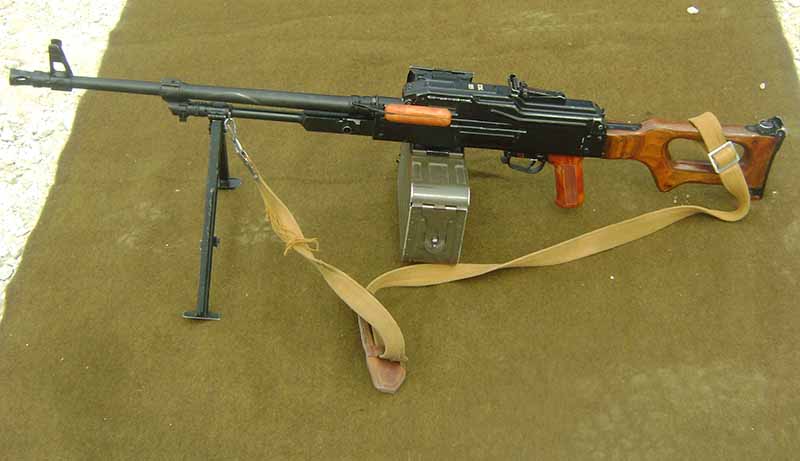
PKM machine guns are another Soviet weapon that were still commonly used by ANA forces before their surrender. Like the AK, many PKMs were left over from previous conflicts in the region, but more still were supplied by the U.S. and NATO later on. The PKM is a belt-fed general-purpose machine gun chambered for the full-powered 7.62x54R cartridge. The original PK version entered Soviet service in 1961 and a modernized version is still used by the Russian army today. It is also still used by dozens of armed groups, both state and non-state, across the globe. Lightweight for a machine gun and extremely reliable, it is not an uncommon opinion to regard the PKM as the best general-purpose machine gun ever made. Both the Taliban and ANA used these extensively for ground troops as well as vehicle-mounted weapons.
RPG-7
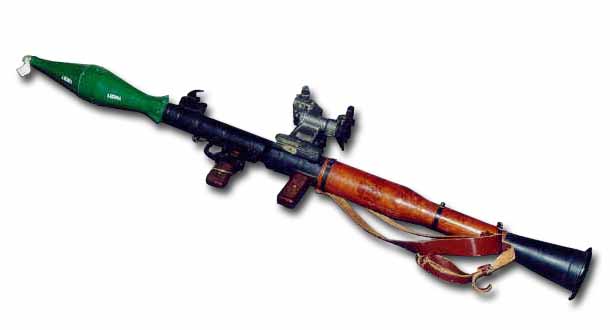
Perhaps the most iconic shoulder-mounted rocket launcher of all time, this Soviet-designed weapon has been used in most major conflicts since Vietnam. Produced not only by the USSR/Russia but several Warsaw Pact nations as well as China, it would be an understatement to say that the RPG-7 gets around. It fires unguided, rocket-propelled grenades of several different varieties, with warheads designed to do everything from penetrating armor to engaging groups of enemy personnel. Again, these have been prevalently used by both sides of the Afghan conflict since before America’s involvement in the region, so the ANA’s stockpile of RPG-7s and rockets will merely supplement the Taliban’s existing collection. Despite being unguided, in the hands of a skilled user, the RPG can be a very serious threat to helicopters.
Elwood Shelton and Adam Borisenko contributed to this report.
Primary Sources for this article:
Long Wars Journal: Afghan National Security Forces Order of Battle
Reuters: Planes, guns, night-vision goggles: The Taliban's new U.S.-made war chest
Wall Street Journal: Taliban Seize U.S. Weapons in Afghanistan, Stockpiling Helicopters, Guns and Trucks
More Military Firearms:
- M24 Sniper Rifle: The Long-Range Legend
- M1 Garand: America’s Original Battle Rifle
- Browning Automatic Rifle: The Gun That Changed the Infantry
- The SVD Dragunov: The World’s Most Prolific Sniper Rifle

Next Step: Get your FREE Printable Target Pack
Enhance your shooting precision with our 62 MOA Targets, perfect for rifles and handguns. Crafted in collaboration with Storm Tactical for accuracy and versatility.
Subscribe to the Gun Digest email newsletter and get your downloadable target pack sent straight to your inbox. Stay updated with the latest firearms info in the industry.

![Best Concealed Carry Guns In 2025 [Field Tested] Wilson Combat EDC X9S 1](https://gundigest.com/wp-content/uploads/Wilson-Combat-EDC-X9S-1-324x160.jpg)


![Best 9mm Carbine: Affordable PCCs [Tested] Ruger Carbine Shooting](https://gundigest.com/wp-content/uploads/Ruger-Carbine-Shooting-100x70.jpg)
![Best AR-15: Top Options Available Today [Field Tested] Harrington and Richardson PSA XM177E2 feature](https://gundigest.com/wp-content/uploads/Harrington-and-Richardson-PSA-XM177E2-feature-100x70.jpg)

Wonderful post. Thanks for sharing this informative article. Indeed these sites list is very helpful for me to create some relevant backlinks for my sites. please keep it up Maintains!
smith and Wesson 65 2
For a long time, I was looking for the answer to this question,smith and Wesson 65 2
but this article of yours has fulfilled my curiosity. Thank you very much for sharing.
Did ole Sleazy “Bought ‘N” Paid For” Senile Ole Joey personally sign the ITAR paperwork transferring those arms to our terrorist enemy??? How many lifetimes would a Patriot spend in prison for supplying just one AR to an enemy?
If there are 600,000 small arms there will be a lot more than 3 million rounds of ammunition for them
The cowards of the ana all want to come to the USA. That’s a crime in itself. Those weapons planes artillery s as re going to be used against us unless we bomb the whole country no matter whose left
Taliban “Mini-Guns”
FREE!! FOR GODS SAKE !!
Just what we need.
BUT Joe wants your guns NOW!
Down here we call this a Major F.U. – FUBAR, OR BOHICA
Cant get much more STUPID, IGNORANT, “DA”.
“I” cant even afford a SIG and they get um FREE!!
WTF !!!!
Not to mention Trijicon Optics +
Saw them on some of he Taliban – Bastards – Guns.
I sure cant afford those.
OF COURSE they are. It was the communist’s plan all along. Now the Chi-Coms and Soviets have full access to our most top secret avionics. They can reverse engineer, copy and counter them now. Xiden or his puppet masters intended for that to happen. Treasonous bastards.